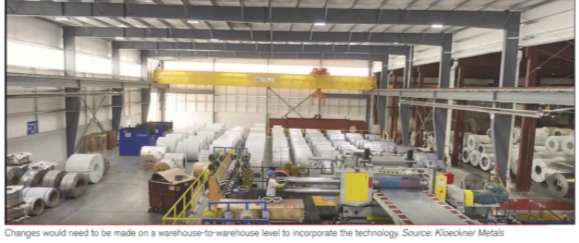

By Matt Meyer and Evan Partalis, April 2018
Radio Frequency Identification (RFID) has come a long way since Walmart first trumpeted its value 10 years ago after retrofitting their supply chain with the tags. Since then, the variety of tags out there has multiplied and the price has dropped precipitously. Meanwhile, the sophistication of RFID programs has expanded, routinely incorporating both Bluetooth and GPS in holistic tracking systems that have redefined inventory tracking and supply chain efficiency. Macy’s has since experimented with augmented, item-level RFID tracking for apparel and footwear and achieved great results in transparency and reduced costs. The sophistication of RFID programs in retail is only growing and its use has the potential to redefine inventory tracking and supply chain efficiency across manufacturing.
In that time, RFID has been ignored by appliance manufacturers because metal and radio frequency don’t tend to get along: metal reflects radio waves. But, with expanded programs, new technologies, and sharply reduced costs, that may soon change. As in retail, the need is there. Appliance manufacturers have complicated supply chains, including massive facilities and lots of products coming down the pipeline. And, just as in retail, the excitement is there too. RFID programs are today both promising and economical.
The Benefits of RFID to Appliance Manufacturers
The benefits to the level of transparency that RFID programs lend manufacturers are numerous. The biggest is the opportunity for data-driven efficiencies. With a combination of BLE and RFID technology, appliance manufacturers would be able to take a fresh look at their factory and warehouse floors, and understand how materials move through their facilities. Managers could target layout, where materials are stored, transit, how equipment moves, and location, getting not just general location, but XYZ coordinates, understanding how far an item is in from a wall, how many feet away, and how far above the ground. Managers would see with renewed clarity what bottlenecks are disrupting flow and adding overhead.
One of the main benefits of RFID programs is streamlining supply chains with suppliers and customers. An RFID program would give appliance manufacturers unparalleled power to forecast sales, track sales forecasts, and automate replenishment orders when suppliers are low. Supply chain wins through automation would be unparalleled and would make appliance manufacturers world-class leaders in efficiency. And this excludes the value of the data itself, which could be harnessed for a wide range of purposes and benefits.
Currently, businesses that want any shot at managing inventory rely on barcodes. The problem with barcodes is that they multiply man hours, communicate static data, and potentially place employees in dangerous situations. Barcode inventory scanning forces employees to do repeated cycle counts; Walmart got so fed up with this that they by and large banned cycle counts and took the hit in inventory loss. The trouble is that even with frequent cycle counts, the data an employee gets is inaccurate as soon as the cycle is complete because the data is static. Just one movement and the data is out-of-date. Finally, employees don’t have to place themselves in danger trying to scan hundreds to thousands of bar codes in enormous warehouses.
While RFID case studies in the appliance manufacturing sector don’t exist, we have seen great results in other verticals. At the RFID conference last May, Gerdau Ameristeel, a large mill based in the U.S. and Brazil, implemented RFID technology in combination with GPS in their Mexico mill. They were able to gather data on material arriving, departing, and in transit and used Electronic Data Exchange (EDE) to communicate location between their suppliers and customers. The end result was a drastic improvement in employee ability to find material.
Methods to Adopt RFID
Appliance manufacturers can get around the reflective properties of metal by taking advantage of returnable SKIDS, or wood pallets, that are produced by suppliers and incorporate RFID tags. For repeat customers, custom SKIDS can be made for appliance manufacturers that are exchanged back and forth. RFID tags would be most helpful to an appliance manufacturer at the portal level – suppliers could automatically communicate to the manufacturer when materials have shipped and arrived at their facilities.
Inside the warehouse, appliance manufacturers could use a combination of RFID and Bluetooth tags to get around the limitations of RFID and metal. Bluetooth technology is much more resilient to steel interference and would absorb waves from passive RFID tags placed on the appliances themselves. With Bluetooth sensors placed through the warehouse, appliance manufacturers would be able to triangulate the position of specific goods and track them throughout the facility. While Bluetooth sensors and tags are more expensive than passive RFID tags, far fewer would be needed and the overall system would still be economical.
The key to successfully implementing an RFID system and reaping the full range of benefits is that tags are common from supplier to manufacturer to retailer. If RFID tags are strictly internal, it’s much more difficult to draw up a business case with substantial, inarguable ROI. The true value to RFID comes when suppliers, manufacturers, and retailers are using their newfound visibility into the supply chain together to improve orders, reduce excess inventory, and move product faster. Optimally, the three stakeholders will augment their RFID use with EDI to automate and streamline much of the communication that accompanies supply chain movement, but other communication technologies exist too.
The time from ideation to implementation depends, of course, on corporate approval processes and resource availability, but many businesses have implemented RFID programs in warehouses as large as 170,000 square feet in as little as three to six months. With appliance manufacturers, the implementation process would necessarily be smoother than in the retail sector: it’s much more economical to track large appliances than it is to track huge numbers of inexpensive or small SKUs. Depending on the parameters and level of transparency that manufacturers desire, most of the work and cost be upfront.
Challenges to Adopting RFID
Implementation of an RFID system to track materials throughout the supply chain requires tight process control and addition training. Make no mistake: process control will have to change to accommodate the technology and take advantage of it in the most efficient way possible. While Bluetooth and GPS sensors are sturdier, the cheaper passive RFID tags are still easily damaged by forklifts or poor material handling practices – changes would need to be made on a warehouse-to-warehouse level to incorporate the technology. Meanwhile, as much as RFID technology resonates with the appliance manufacturing sector, there still isn’t much industry experience in implementation. The bright side to this is that suppliers with experience in multiple verticals, like automotive, have the experience and capacity to customize systems to the needs of appliance manufacturers. Especially for appliance manufacturers with long-term, stable vendor relationships, a level of partner coordination would do much good to smooth implementation. After all, supply chain transparency and efficiency benefits suppliers and customers as much as it does manufacturers.
The Future of RFID
The future of RFID will be even more robust. Already, RFID programs are encoded with far more information – like weight and flexible parts numbers – than ever before, and SKIDs are outfitted with scales so managers can understand, for example, the number of sheets per SKID. We’re seeing the beginnings of real-time communication between product movement and inventory systems, but the real promise will be in how that data is analyzed and leveraged in the long term. We predict automatic inventory tracking technology all the way from the mill to the end customer, with automated purchase and replenishment orders every step of the way. In fact, the data that companies gather and process will become their greatest competitive advantage, going beyond the supply chain to every facet of the warehouse, including cranes, forklifts, heavy machinery, and trucks.
Data will become every company’s greatest asset, and a robust RFID program is just the start.
One company that’s leading the way in RFID implementation is, of course, Amazon. Last year, they launched test store Amazon Go in Seattle and it operates a retail store like a mini, RFID optimized warehouse. Customers enter the store, hold their phone over a Bluetooth connection to track the phone’s unique code and identify their Amazon account number. Every item in the store has a passive RFID tag costing 10 cents to 20 cents each. Customers put items into their carts and are automatically charged to their Amazon account when they leave the store. Meanwhile, Amazon gets live data on stock and sales, reduced theft and product loss, and streamlines headcount. Manufacturers can do the same – and the gains will be even more profound.

Article may be found: http://digital.bnpmedia.com/publication/?i=483944#{“issue_id”:483944,”page”:30

Steel base plates are fundamental elements employed in various manufacturing...
Metal fabrication is a critical process that transforms raw metal...
The solar industry has undergone a significant transformation by incorporating...

X
The Kloeckner Metals website uses modern technologies. Unfortunately, your browser doesn't support those technologies.
Download the latest version of one of these browsers to experience the site: